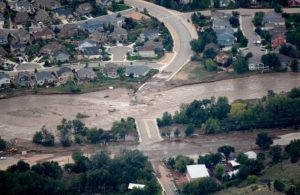Flood
 Floods typically occur between April in October in Boulder County and impact areas along streams and rivers, canyons, ditches, and low-lying areas.
Floods typically occur between April in October in Boulder County and impact areas along streams and rivers, canyons, ditches, and low-lying areas.
Before a flood:
- Know your neighborhood flood history and low-lying areas.
- Consider purchasing flood insurance; most homeowner’s policies do not cover damage from rising water. Your insurance agent will have more information about the National Flood Insurance Program (NFIP).
- Determine if your home and workplace are in a flood plain.
- Stay alert for changing weather conditions.
- When conditions indicate the potential for flooding, get out of low-lying areas, canyons and areas downstream from dams.
- If flooding becomes very likely, consider filling up sinks, bathtubs and other containers with clean water.
During a flood:
- If you receive a flash flood warning, move to higher ground immediately. If you can evacuate safely and have been instructed to do so, move quickly.
- If you cannot evacuate safely, go to the highest floor in your house. Take your emergency supplies with you.
- Do not attempt to cross water that is above your knees.
- Do not drive over a flooded area or around barricades. Abandon a stalled vehicle and immediately move to higher ground.
- Avoid moving water – six inches can knock you off your feet, and 18-24 inches can float a car.
- Avoid standing water – it will likely be contaminated and contain large amounts of debris.
After a flood:
- Follow the instructions of authorities and obey posted warnings.
- Wait for officials to determine if the water is safe to drink.
- Throw away water and food that has come into contact with floodwater.
- Check for utility outages. Utilities will have to be turned back on by a professional.
- Continue monitoring radio and television for information on weather and recovery efforts.
- Consider asking a professional to evaluate your home for mold.
- Use bleach to clean up – it is effective in killing germs, and can also be used to purify water to drink (10-20 drops of plain bleach per gallon of water).
View information about current stream, ditch, and reservoir levels.
